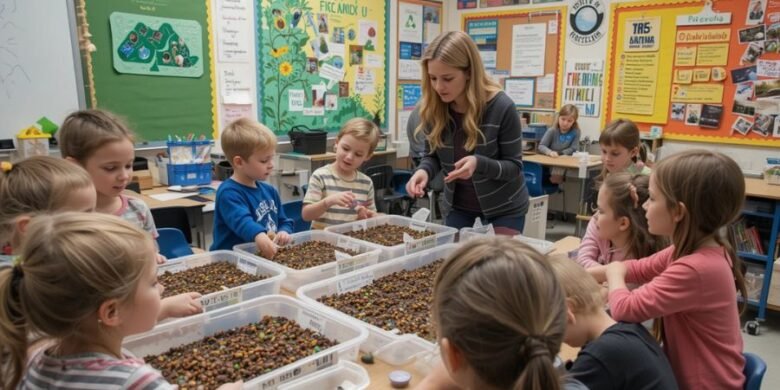Vermiculture, the practice of using worms to recycle organic waste into nutrient-rich compost, is an excellent educational tool for teaching sustainability, biology, and environmental responsibility. Partnering with local schools to promote vermiculture offers a unique opportunity to engage students in hands-on learning while fostering eco-friendly practices. This guide provides practical steps for successful collaboration with schools to introduce and support vermiculture programs.
Why Promote Vermiculture in Schools?
1. Environmental Education
- Teaches students about waste reduction, soil health, and sustainability.
- Encourages lifelong habits of composting and environmental stewardship.
2. Hands-On Learning
- Provides practical experience in science and ecology.
- Connects classroom lessons to real-world applications.
3. Community Impact
- Reduces school-generated organic waste.
- Inspires families and the local community to adopt sustainable practices.
Steps to Collaborate with Schools
Step 1: Identify Schools to Partner With
Start by reaching out to schools in your community:
- Elementary Schools: Ideal for introducing simple concepts about worms and composting.
- Middle and High Schools: Perfect for more advanced topics like ecosystem dynamics and waste management.
Tip: Focus on schools with existing eco-clubs, gardening programs, or sustainability initiatives.
Step 2: Propose a Vermiculture Program
Develop a clear and compelling proposal to present to school administrators or teachers:
- Explain the benefits of vermiculture for education and sustainability.
- Outline how the program aligns with educational goals and curricula.
- Highlight the minimal costs and effort required to maintain a worm farm.
Include a plan for implementation, such as setting up a worm bin in the classroom or integrating vermiculture into science lessons.
Step 3: Provide Training and Resources
Offer to train teachers and students on the basics of worm farming:
- Conduct workshops or demonstrations to explain how to set up and maintain a worm bin.
- Provide starter kits with worms, bedding, and instructional materials.
- Share resources like videos, handouts, and troubleshooting guides.
Designing Vermiculture Activities for Schools
1. Setting Up a Classroom Worm Bin
Guide students through the process of creating their own worm bin:
- Materials Needed: A container, bedding (e.g., shredded newspaper), and red wigglers.
- Activity: Have students prepare the bedding, add worms, and feed them food scraps.
- Educational Tie-In: Discuss the role of worms in decomposing organic matter and enriching soil.
2. Science Experiments
Incorporate vermiculture into hands-on science projects:
- Decomposition Rates: Compare how quickly different types of waste (e.g., vegetable scraps vs. paper) break down in a worm bin.
- Worm Behavior: Observe how worms respond to changes in light, moisture, or food types.
- Soil Quality: Test the effects of worm castings on plant growth compared to regular soil.
3. Art and Creative Projects
Combine vermiculture with creative learning:
- Have students draw or craft models of worms and their ecosystems.
- Create posters or presentations to educate peers about composting.
4. Waste Reduction Challenge
Organize a school-wide challenge to reduce food waste:
- Encourage students to collect food scraps for the worm bin.
- Track the amount of waste diverted from landfills and celebrate milestones.
Engaging the Wider School Community
1. Parent and Teacher Involvement
- Host informational sessions for parents and teachers to explain the program’s goals and benefits.
- Encourage families to start their own worm bins at home.
2. School Events
- Feature vermiculture displays or demonstrations at science fairs and open houses.
- Organize “composting days” where students and staff can contribute food scraps to the worm bin.
3. Collaborate with Local Organizations
- Partner with gardening clubs, environmental groups, or businesses to support the program.
- Seek sponsorships or donations for materials like bins and worms.
Overcoming Challenges
1. Misconceptions About Worm Farming
- Address concerns about odor or pests by demonstrating proper bin management.
- Highlight the minimal maintenance required for a healthy worm bin.
2. Lack of Funding
- Apply for grants focused on environmental education or sustainability.
- Organize fundraisers or seek local business sponsorships.
3. Maintaining Interest
- Keep the program engaging with regular updates, new activities, and competitions.
- Rotate student responsibilities to ensure everyone stays involved.
Success Stories: Vermiculture in Schools
Example 1: Elementary School Composting Program
An elementary school in California introduced vermiculture to reduce cafeteria waste. Students managed the bins as part of their science curriculum and used the compost in a school garden, fostering pride and environmental awareness.
Example 2: High School Sustainability Club
A high school in Australia incorporated vermiculture into its sustainability club. The program not only reduced organic waste but also inspired students to advocate for environmental policies within their community.
Conclusion
Collaborating with local schools to promote vermiculture is a powerful way to educate young minds about sustainability while creating a positive environmental impact. By providing resources, guidance, and engaging activities, you can inspire the next generation to embrace eco-friendly practices. Start small, build strong partnerships, and watch as your efforts help cultivate a greener future.




